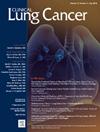Multicentre Validation of the RESECT-90 Prediction Model for 90-Day Mortality After Lung Resection
IF 3.3
3区 医学
Q2 ONCOLOGY
引用次数: 0
Abstract
Background
The RESECT-90 model was developed to predict 90-day mortality for patients undergoing lung resection but hasn't been externally validated. The aim of this study was to validate the RESECT-90 clinical prediction model using multicentre patient data from across the United Kingdom (UK).
Materials and Methods
Data from 12 UK thoracic surgery centers for patients undergoing lung resection between 2016 and 2020 with available 90-day mortality status were used to externally validate the RESECT-90 model. Measures of discrimination (area under the receiving operator characteristic curve [AUC]) and calibration (calibration slope, calibration intercept and flexible calibration plot) were assessed as measures of model performance. Model recalibration was also performed by updating the original model intercept and coefficients.
Results
A total of 12,241 patients were included. Overall 90-day mortality was 2.9% (n = 360). Acceptable model discrimination was demonstrated (AUC 0.74 [0.73, 0.75]). Calibration varied between centers with some evidence of overall model miscalibration (calibration slope 0.80 [0.66, 0.95] and calibration intercept 0.40 [0.29, 0.52]) despite acceptable appearances of the flexible calibration plot. The model was subsequently recalibrated, after which all measures of calibration indicated excellent performance.
Conclusions
After external validation and recalibration using a large contemporary cohort of patients undergoing surgery in multiple geographical locations across the UK, the RESECT-90 model demonstrated satisfactory statistical performance for the prediction of 90-day mortality after lung resection. Whilst the recalibrated model will require ongoing validation, the results of this study suggest that routine use of the RESECT-90 model in UK thoracic surgery practice should be considered.
肺切除术后 90 天死亡率 RESECT-90 预测模型的多中心验证。
背景:RESECT-90模型用于预测肺切除术患者的90天死亡率,但尚未经过外部验证。本研究旨在利用英国各地多中心患者数据验证 RESECT-90 临床预测模型:来自英国12个胸外科中心的2016年至2020年间接受肺切除术的患者数据(90天死亡率情况可查)被用于对RESECT-90模型进行外部验证。作为模型性能的衡量标准,对辨别度(接受操作者特征曲线下面积 [AUC])和校准度(校准斜率、校准截距和灵活校准图)进行了评估。还通过更新原始模型截距和系数对模型进行了重新校准:结果:共纳入 12241 名患者。90天总死亡率为2.9%(n = 360)。模型区分度可接受(AUC 0.74 [0.73, 0.75])。各中心的校准结果不尽相同,尽管灵活校准图的显示结果可以接受,但仍有一些证据表明整体模型存在校准误差(校准斜率为 0.80 [0.66, 0.95],校准截距为 0.40 [0.29, 0.52])。随后对模型进行了重新校准,校准后的所有指标均显示出良好的性能:结论:在使用英国多个地区接受手术的大型当代患者队列进行外部验证和重新校准后,RESECT-90 模型在预测肺切除术后 90 天死亡率方面表现出令人满意的统计性能。虽然重新校准后的模型需要不断验证,但本研究结果表明,应考虑在英国胸外科实践中常规使用 RESECT-90 模型。
本文章由计算机程序翻译,如有差异,请以英文原文为准。
求助全文
约1分钟内获得全文
求助全文
来源期刊

Clinical lung cancer
医学-肿瘤学
CiteScore
7.00
自引率
2.80%
发文量
159
审稿时长
24 days
期刊介绍:
Clinical Lung Cancer is a peer-reviewed bimonthly journal that publishes original articles describing various aspects of clinical and translational research of lung cancer. Clinical Lung Cancer is devoted to articles on detection, diagnosis, prevention, and treatment of lung cancer. The main emphasis is on recent scientific developments in all areas related to lung cancer. Specific areas of interest include clinical research and mechanistic approaches; drug sensitivity and resistance; gene and antisense therapy; pathology, markers, and prognostic indicators; chemoprevention strategies; multimodality therapy; and integration of various approaches.
 求助内容:
求助内容: 应助结果提醒方式:
应助结果提醒方式:


